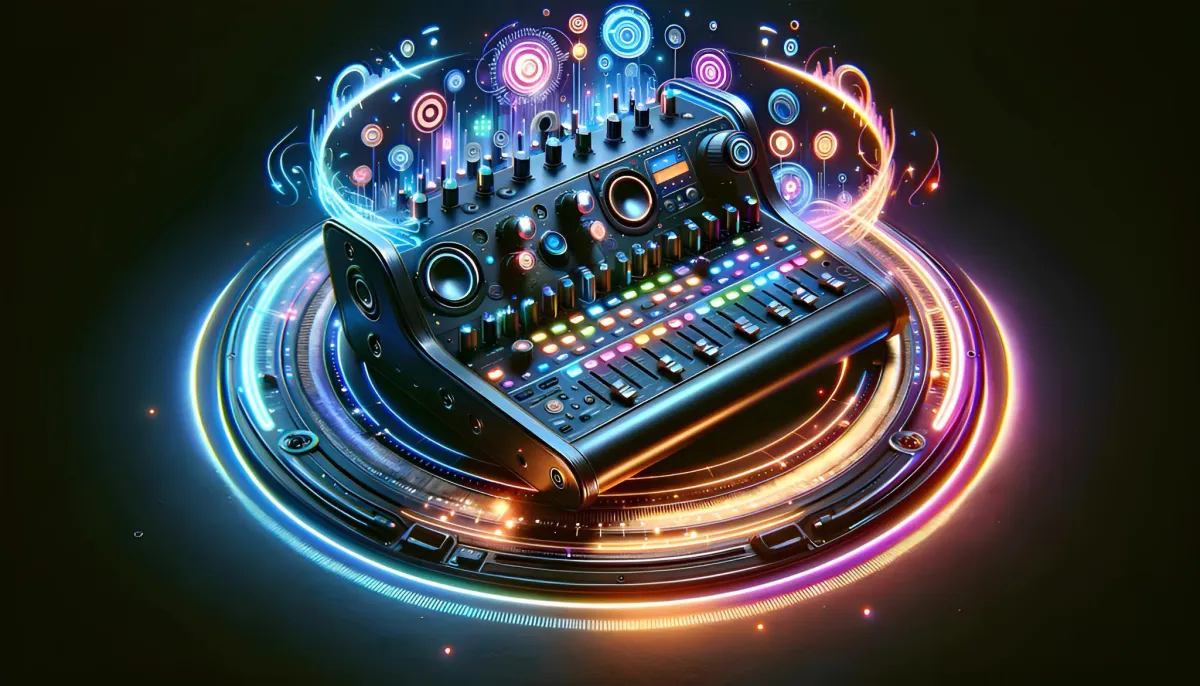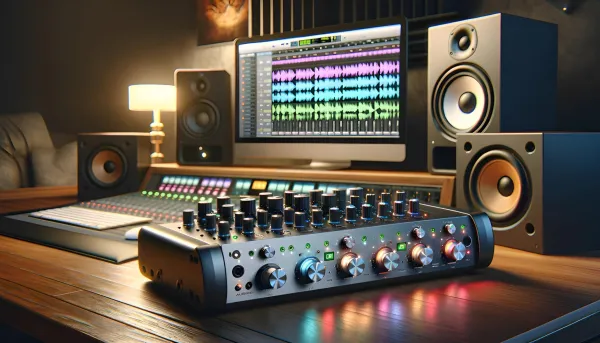In the quest to elevate our audio production from the mundane to the sublime, the first port of call is often the humble audio interface. This piece of equipment acts as the critical bridge between the analog warmth of our world and the binary precision of our digital workstations. To ensure you're well-armed for this pivotal choice, let's delve into the foundational considerations that should guide your quest.
Understanding Your Needs
Before even considering your options, it's important to consider what's within your budget. If you need ideas for financing an audio interface, I definitely recommend checking out my article on the 11 Best Places to Finance an Audio Interface with Any Credit Type. As a part of this process, it's also imperative to take stock of what you truly need. Are you a solo artist looking to record vocals and guitar in the quiet sanctum of your bedroom studio? Or are you ambitiously planning to capture the chaotic harmony of a full band? The scope of your ambition will dictate the scale of the interface you require.
Connectivity: The Lifelines of Your Musical Endeavors
The heart of an audio interface lies in its inputs and outputs (I/O). Here, quality and quantity both play their roles. For the uninitiated, it's easy to fall into the trap of "more is better," but the savvy buyer understands that the right balance is key.
- Inputs: Look for interfaces with a combination of XLR and 1/4" inputs. XLR inputs are your go-to for microphones, ensuring that the soul-stirring nuances of your vocals are captured in their full glory. The 1/4" inputs, meanwhile, are indispensable for guitars and other line-level instruments. A pro tip? Opt for interfaces with 'combo' inputs, offering the best of both worlds without cluttering your space.
- Outputs: Your output needs might seem secondary, but they're crucial for monitoring and mixing. Besides the main stereo output, consider additional outputs if you foresee the need to send audio to different destinations, such as external processors or mixers.
Preamps: The Unsung Heroes
The preamp quality in an audio interface is akin to the foundation of a house – crucial, yet often overlooked. A stellar preamp ensures your recordings capture the true essence of the source, with all its dynamics and color. Lower-quality preamps can leave your audio sounding lifeless or introduce noise, turning your quest for audio perfection into a Sisyphean ordeal.
Digital Conversion: Crossing the Analog-Digital Divide
At the core of the interface's purpose is the conversion of analog signals into digital ones and vice versa. This process is where the magic happens, and the quality of this conversion can greatly affect the fidelity of your recordings. Look for interfaces that boast high-resolution conversion (24-bit/192kHz is a good benchmark), ensuring that your digital recordings are a faithful reproduction of your analog inputs.
Latency: The Nemesis of the Digital Age
Latency – the delay between playing or singing a note and hearing it through your headphones or speakers – can be a creativity killer. Modern interfaces have made significant strides in reducing latency to nearly imperceptible levels. However, it's still a critical factor to consider, especially if you're planning to use virtual instruments or real-time effects processing.
Software Compatibility: The Tie that Binds
In our digital age, the audio interface must seamlessly integrate with your recording software. Whether you're a devotee of Ableton, Logic, Pro Tools, or any other Digital Audio Workstation (DAW), ensuring compatibility is non-negotiable. Look for interfaces that either come bundled with DAWs or boast certified compatibility with your software of choice.
Durability and Portability: The Road Warriors' Creed
For those of us who find inspiration in the chaos of the road or the tranquility of remote locations, the build quality and portability of our interface are paramount. A robustly built interface can be the difference between a successful recording session and a catastrophic failure. If you're constantly on the move, consider the interface's size and weight, as well as its durability against the rigors of travel.
In wrapping up this first installment of our guide, remember that an audio interface is not just a purchase; it's an investment in your musical journey. As we've embarked on this exploration of the critical aspects of an audio interface, let these insights be the guiding light in your quest. With the right interface, the world is your studio – a canvas waiting for the colors only you can provide.
Software Bundles: The Sweeteners
Manufacturers often bundle audio interfaces with an array of software to entice the modern-day composer. This software can range from lite versions of popular Digital Audio Workstations (DAWs) to an assortment of plug-ins designed to elevate your production quality from the get-go. While the inclusion of these bundles shouldn't be the sole deciding factor, they can offer a fantastic head start, especially for those at the beginning of their audio journey. Evaluate the bundled software not just by quantity but by how well it aligns with your production style and needs. A suite of high-quality effects, virtual instruments, and even educational materials can be a boon, significantly enhancing the value of your investment.
Budgeting: Striking the Right Chord
The adage "you get what you pay for" is often true in the world of audio interfaces, but it doesn't mean you have to break the bank to acquire quality. The key is to balance your financial outlay with your actual needs. Entry-level interfaces can provide astonishing quality suitable for a variety of applications, while high-end interfaces offer enhancements that, while notable, may be overkill for your specific use case. Consider not only the purchase price but also the potential need for additional equipment (microphones, cables, stands) to fully utilize your new interface. It's prudent to allocate your budget in a way that covers the entirety of your setup, ensuring no component is a weak link in your audio chain.
Latency Revisited: The Quest for Real-Time Performance
Latency was touched upon in our first part, but its importance cannot be overstated, particularly for those engaging in live performances or utilizing software instruments. Modern interfaces and their accompanying software offer a range of solutions to mitigate latency, from direct monitoring features that bypass the computer's processing to proprietary drivers designed to minimize delay. When choosing an interface, consider these features carefully. The ability to hear yourself in real-time without the disorienting echo of latency can be the difference between a seamless creative process and a frustrating battle against time.
Connectivity Revisited: Future-Proofing Your Studio
As your skills and studio grow, so too will your connectivity needs. Future-proofing your studio means considering not just your current setup, but what you aspire to build. Interfaces that offer expandability through ADAT or S/PDIF can grow with you, allowing for additional inputs and outputs without the need for a completely new device. Additionally, the interface's connection to your computer (USB, Thunderbolt, FireWire) can impact data transfer rates and latency, with newer standards like Thunderbolt offering superior performance at a higher price point.
Driver Stability: The Unsung Hero of Reliability
The best hardware in the world means little if it's crippled by unreliable software. Driver stability can greatly affect your interface's performance and your overall satisfaction. Researching and reading reviews on the stability of the drivers for your chosen interface can save you countless hours of troubleshooting and frustration. Look for interfaces from manufacturers with a solid track record of regular updates and support for various operating systems.
Ecosystem Compatibility: Beyond the Interface
Some audio interfaces are part of a larger ecosystem, designed to work seamlessly with specific software or hardware. This can be particularly appealing for users already invested in a certain ecosystem or those looking for a streamlined workflow. For instance, certain interfaces offer deeper integration with specific DAWs, providing enhanced control surfaces or proprietary features not available with third-party hardware.
The Personal Touch: Ergonomics and Aesthetics
Lastly, never underestimate the importance of how an interface feels and looks. The ergonomics of its design, the placement of knobs and inputs, and even its aesthetic appeal can influence your creative flow. An interface that inspires you, that feels intuitive and satisfying to use, can be a catalyst for creativity. After all, the best gear is the gear that you love to use.
Navigating the Sea of Additional Features
Modern audio interfaces can come packed with a plethora of additional features that, while potentially beneficial, can also muddy the waters of decision-making. Understanding which features align with your workflow is key.
- Onboard DSP (Digital Signal Processing): Some interfaces offer onboard DSP, which provides real-time effects processing without taxing your computer's CPU. This can be a game-changer for those looking to use effects live or during tracking sessions.
- Loopback Functionality: Particularly useful for podcasters and streamers, loopback allows you to capture the audio from your computer (such as a Skype call or game audio) along with your mic inputs, all within the interface.
- Talkback and Built-In Microphones: For those recording others, interfaces with built-in talkback functionality can simplify communication between the control room and the recording booth. Some models even include a built-in microphone for this purpose, eliminating the need for an additional talkback setup.
User Interface and Workflow Efficiency
The physical and software interfaces of your audio interface can greatly impact your workflow. Knobs, buttons, and touchscreen panels should offer intuitive access to essential functions without the need to dive into submenus. A cluttered or non-intuitive layout can hamper creativity and slow down the recording process.
Software control panels are just as crucial. They should provide easy access to input levels, routing options, and other settings without overwhelming you with complexity. A well-designed user interface can make setup and adjustment tasks significantly more straightforward, allowing you to focus on what truly matters: your music.
Community and Manufacturer Support: The Unsung Pillars of Longevity
The community that surrounds a product and the support provided by the manufacturer can greatly influence your long-term satisfaction with an audio interface.
- Manufacturer Support: Good manufacturer support can be a lifeline, offering firmware updates that fix bugs and enhance functionality, as well as providing timely assistance when issues arise. Check for the responsiveness of their customer service and the availability of comprehensive documentation.
- Community Forums and Resources: A vibrant user community can be a treasure trove of information, offering unofficial troubleshooting, user-created content like presets or templates, and valuable advice from real-world users. Before making a purchase, explore forums, Reddit threads, and social media groups dedicated to the interface or brand you're considering.
Considering the Ecosystem: The Bigger Picture
Beyond the interface itself, consider the broader ecosystem it's part of. Some interfaces work seamlessly within specific environments or with particular software/hardware, offering extended functionality that can be a significant advantage. This might include exclusive plugins, advanced integration with DAWs, or compatibility with digital control surfaces.
Aesthetic Considerations: The Place of Beauty in Functionality
While the functionality should always be a priority, the aesthetic appeal of an audio interface can also play a role in your creative environment. A piece of equipment that inspires you or fits beautifully within your studio space can enhance your desire to create. Don't underestimate the motivational impact of using gear that you find visually appealing and ergonomically satisfying.
Making the Final Decision: A Harmony of Needs and Wants
The journey through specifications, features, and considerations brings us to a critical juncture - the decision point. Here, it’s essential to balance your aspirations with practicality. Reflect on the insights garnered from the previous segments and prioritize your requirements. Does the potential interface align with your current and future project needs? Is it compatible with your existing setup? How does it fare in terms of user reviews and community feedback? Making a list of must-haves versus nice-to-haves can clarify your decision, focusing on what truly matters for your audio production endeavors.
Budget Reconsiderations: A Final Audit
Revisit your budget with fresh eyes, considering not only the cost of the interface but also any ancillary expenses it may necessitate, such as cables, microphones, or additional outboard gear. It’s prudent to factor in these costs upfront to avoid any surprises down the line. Remember, investing in quality now can save you from costly upgrades in the future.
The Integration Process: Setting the Stage for Success
Once your choice is made and your new audio interface arrives, the focus shifts to integration. Proper setup is paramount to ensure that the interface performs at its peak within your environment.
- Driver Installation and Updates: Begin by installing the latest drivers from the manufacturer's website, ensuring compatibility and access to all features.
- Connection and Testing: Connect the interface to your computer and hook up your monitors, instruments, and microphones. Conduct a series of tests to confirm everything is operating as expected, paying close attention to any latency or connectivity issues.
- Software Configuration: Dive into your DAW and other software to configure them to recognize and utilize the new interface. This might involve selecting it as the primary audio device and adjusting input/output settings.
- Monitor Calibration: If you’re using studio monitors, take the time to calibrate them with your interface. This ensures accurate sound reproduction and a more trustworthy mixing environment.
Learning and Growth: Beyond the Initial Setup
With your interface integrated into your setup, the journey is far from over. It’s a relationship that will evolve as you delve deeper into its features and capabilities.
- Explore Advanced Features: Dedicate time to explore onboard DSP, loopback functions, and other advanced features. Understanding these can enhance your recording and mixing techniques.
- Stay Updated: Keep an eye on firmware and driver updates from the manufacturer. These can address issues, improve performance, and sometimes even add new features.
- Engage with the Community: Participate in forums and social media groups related to your interface. The collective wisdom of the community can provide invaluable tips, tricks, and advice.
Reflecting on the Journey
Choosing the right audio interface is a critical step in your musical journey, one that influences the quality of your productions and the fluidity of your creative process. By considering the factors laid out in this guide, you're well-equipped to make a choice that aligns with your ambitions, budget, and workflow.
In the end, the "perfect" audio interface is the one that best meets your unique needs, enabling you to capture and express your artistic vision with clarity and precision. It’s an investment in your musical future, laying the groundwork for countless hours of creative exploration and expression.
As this guide comes to a close, remember that the learning never stops. The landscape of audio production is ever-evolving, with new technologies, techniques, and philosophies emerging. Stay curious, remain open to growth, and let your audio interface be a gateway to new realms of sonic excellence. Here’s to the music you’ll make and the stories you’ll tell through the universal language of sound.








